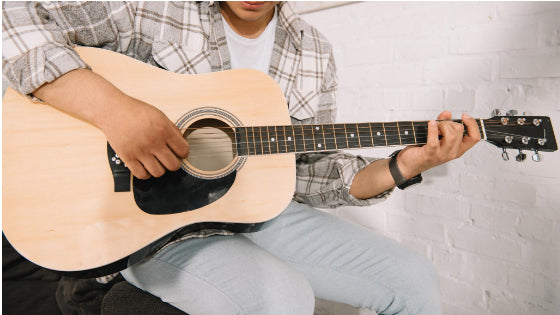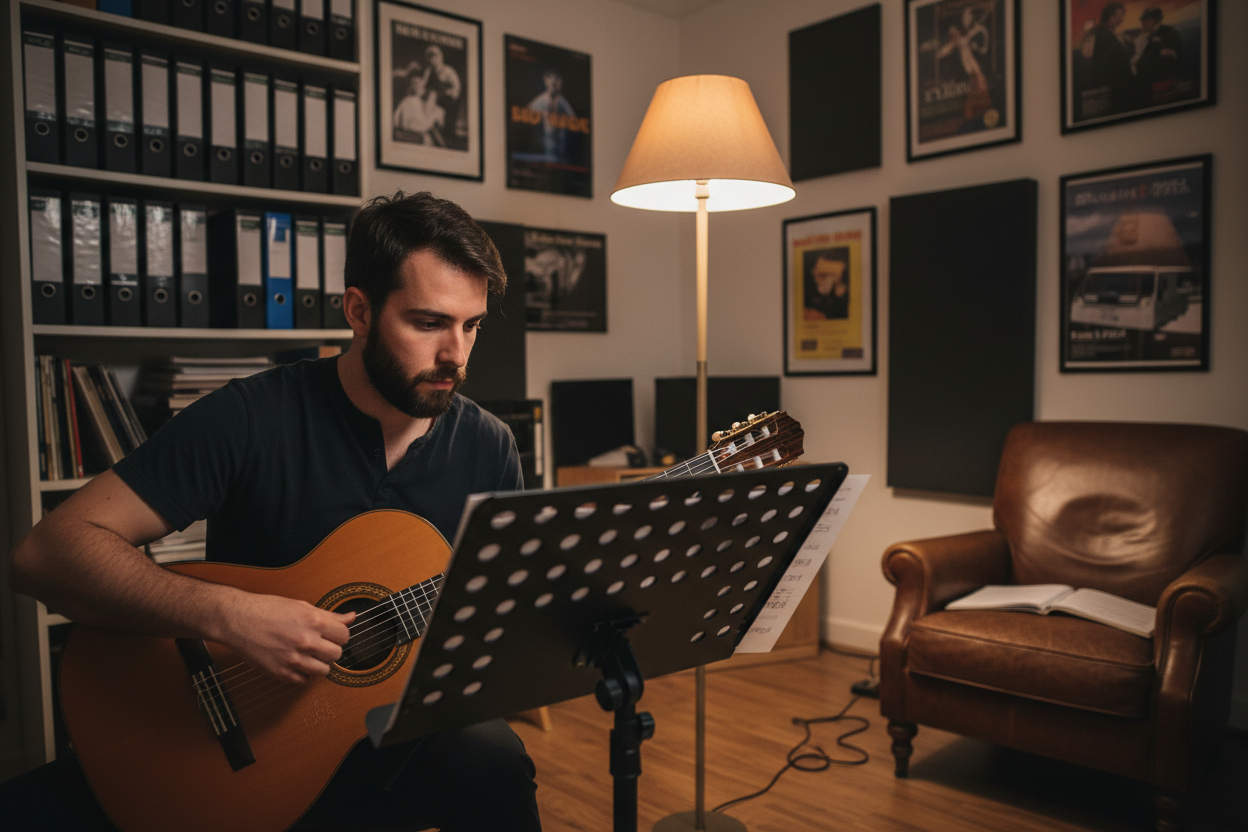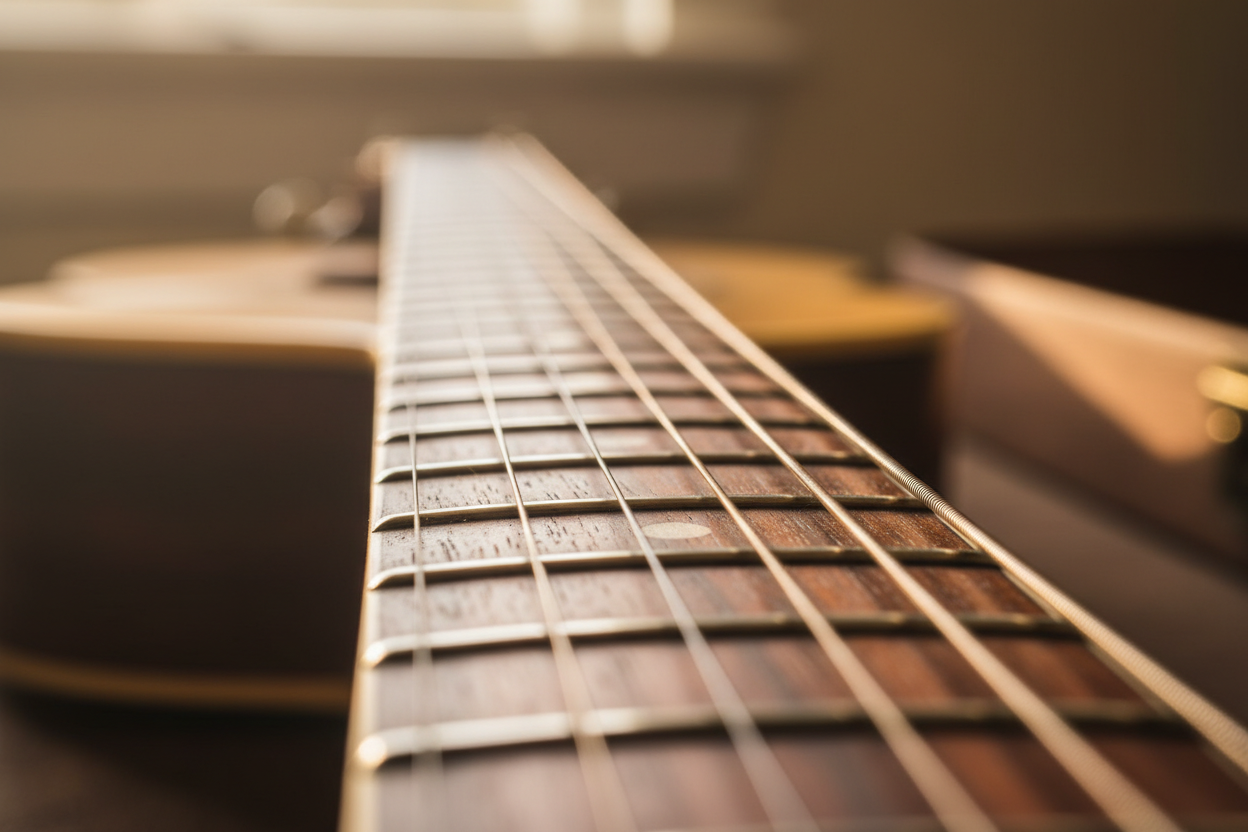The looks, the purpose, the sound. This sums up the difference in guitar body shapes. Adding aspects of playability, when choosing a guitar, you get a feeling that the body is everything. If you are picking your guitar just by how it looks, you may notice after a while that it’s not “working as intended”. This is because the body of an acoustic guitar is the cornerstone for various aspects of its sound.
The differences guitar body shapes bring out are the differences in what you intend to do with your guitar. Let’s explore what the body shape does in an acoustic guitar and how you can choose.
Acoustic Guitar Body 101
Starting from the start. You probably tried to strum a ribbon or a thread and hear a slight sound it makes. Or, you’ve tried to play an unplugged electric guitar. The sound they make is not too loud.
If you had an acoustic guitar without its box somehow, it would sound very similar. This is why we have larger guitar bodies. I imagine them as hollow boxes that contain some sound and vibrations that enter them.
We then remember echo. This gives us the idea that sound can “hit” an object and “return” to the sender.
Combine the two and you’ll understand the reason we have hollow bodies on acoustic guitars. They are there not only to have sound waves enter them but also “bounce” around until they find the exit. This kind of gathers them like air in a balloon, so they are released more at once. More sound waves, more volume.
Advanced Guitar Body -201
Three more important things to remember about sound.
The first one is that the sound wave can also be “soaked”, partially or totally.
The second one is that the soaking and bouncing we mentioned depends on the length of a sound wave and the material. How materials work is weird so we won’t get into that.
The point is that, when a sound wave hits something, it changes, and the result can be a variety of different sound lengths, complete disappearance of the sound wave, or a perfect bounce.
Finally, sound waves add up or cancel each other in weird but sometimes beautiful ways.
That’s what the guitar body does. It lets sound waves bounce around, soak a bit, and add up to the particular sound of the guitar you’re playing.
Practical appliance
The material the body is made of has a major role in it, but also the shape and the size. Together, they create the playground for the sounds and determine what sounds get to play, and how they’ll play out.
How? Three words: Volume, pitch, and timbre. Timbre is the “color” of the guitar’s tone – if two singers sang the same thing, you’d know them by their voice (that’s Mick, and that’s James). Different body shapes allow for variations of volume across the pitch line and sound waves that create the guitar’s timbre.
Larger guitars add up more volume, more to the bass and low ends. Smaller guitars feel more balanced. More difference between the waist and the bouts (the “shoulders” and “hips), less bass, and more mid. Treble sound waves are so short that the material affects them more (metal boxes have more ring compared to the natural tones of wood boxes).
We can now talk about subtleties. The size of a guitar's body ever so slightly changes the playability of a guitar. Children would have difficulties playing guitars with large bodies. More importantly, even if you can play any, the size subtly changes the body posture and the position of arms and hands. Small guitars are more intimate and are usually better for fingerpicking, for example, while large is better for strumming chords.
Basic Types of Guitar Shapes
Now we get to see the different body shapes in practice. This should help you get an idea of what to check further and what you want to avoid. Remember, the more you try, the better you’ll get the differences.
Travel

This is the smallest guitar type and it’s very practical for traveling musicians and children. You don’t get much bass and volume out of it. Like a child compared to a grown man, these guitars give off a more high-pitch, trebly voice. They are very responsive and somewhat balanced across different octaves, with uniformity across octaves.
They are the choice and go-to for full-on beginners, children, and street musicians that travel a lot. They are good for both fingerpicking and strumming, and sing-alongs. Some may feel limited by the sounds they project when singing along, but many professionals picked them as favorites, like Sheeran and Taylor Swift.
Parlor

Next in line by size, parlor guitars are considered “adult” guitars. They are similar to classical guitars since the neck and the body meet at the 12th fret. The biggest differences in size are in the lower bout and the guitar’s debt. They, therefore, feel more intimate and fickle when playing.
The parlor is the pivot of a well-balanced timbre and volume. Every note picked feels as balanced as tones on the piano, if not more. They still lack bass and volume, but it doesn’t mean they’re quiet. Bob Dylan used parlor for most of his songs.
The concert, Grand Concert

We get into a group of guitars with different names and small differences. These differences are reserved for those that know exactly what they want and are okay with limits in the bass. We’ll name the variations here: 0, 00, 000, OM. There are alternative namings, like As, GA, and some vendors and manufacturers would tell you they are different, while some would say they’re the same as 000, or OM, respectively.
The appeal of these guitars lay in the playstyle as well as the balance of timbre and volume. They are still small, with more pronounced differences in waists and bouts. Bouts are also typically more narrow. The strings usually come with more tension, which means more volume and responsiveness. This is great for concert fingerpicking and these guitars are considered “sophisticated”. Cash, Paul Simon, and Clapton were seen using these.
The largest in the group is Grand Auditorium which has the most bass among them, it’s still great for fingerpicking but also allows for strumming and sing-alongs. Breedlove Grand Auditoriums better know as the Concerto size in the Breedlove line are on the rise for their quality sound and excellent presence.
Dreadnought

This is the typical shape most people imagine when they hear the word “guitar”. It’s most probably the one in pictures in language classes. We know this one, your friend has it. Let’s see why they have it.
Dreadnought has fewer curves and more dimensions across x, y, and z. This gives off a lot of bass tones and you can notice much more difference in tone as you are going up the scale. Low notes resonate vibrant, strong, and loud, while high ones clear out. This doesn’t mean you won’t hear them, but say that you play a high-note solo on a dreadnought while your friend follows you on Parlor. There’s the difference if your guitars switched roles, you’d have more presence in chords and clearer solo lines.
This is why dreadnoughts are used at home the most. You can fingerpick if you’d like, but your hands will naturally sit in a strumming position. If you want to sing along and you are baritone and up, it’s the guitar for this kind of thing. Dreadnoughts like Seagull S6 have a quality sound and are preferred by singer-songwriters.
Jumbo
Jumbo has the largest guitar body and the most resonant bass. It borders with a bass guitar that gives off nice resonant chords. It’s usually used as a rhythm guitar in country music since it’s present, great in bass attach, and the percussive element is highly accented.
Yet, it’s big and this almost limits it totally for strumming and large hands and arms.
Summary
This is it, the whole wisdom of it, though the real wisdom comes with experience and knowing what you want. And you won’t know if you want it unless you tried it. It’s like olives. You can hate them the first time, dislike them the second time, and tolerate them the next time. But there may come a time in your life when you just can’t get enough of them.
To sum it up, smaller guitar shapes bring more intimacy and fall naturally in hand for fingerpicking. They lack bass, so they are more like solo singers of their balanced sound and projection. Larger hands are better for strumming, have more accented bass and presence, and are more like a choir of singers that follow the lead singer, be it you or your friend. So, test out a couple of olives before you decide what jar you’ll want to pop.
Written by Marko Jovanovic





